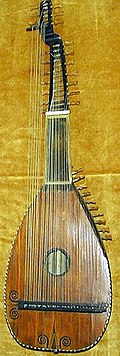Torban
 | |
| Classification |
Chordophone |
|---|---|
| Hornbostel–Sachs classification | 321.321-5 |
| Playing range | |
| Varied | |
| Related instruments | |
The torban (Ukrainian: Торбан, also teorban or Ukrainian theorbo) is a Ukrainian musical instrument that combines the features of the Baroque lute with those of the psaltery.[1] The Тorban differs from the more common European bass lute known as the theorbo in that it had additional short unfretted treble strings (known as prystrunky) strung along the treble side of the soundboard.
Overview
It appeared in the second quarter of the 18th century, probably influenced by the central European
The surviving printed musical literature for torban is extremely limited, notwithstanding the widespread use of the instrument in Eastern Europe. It was an integral part of the urban oral culture in Ukraine, both in Russian and Polish (later Austro-Hungarian Empire) controlled parts of the country (after the split). To date the only notated examples of torban music recorded are a group of songs from the repertoire of Franz Widort; collected by Ukrainian composer and ethnographer
The multi-strung, expensive in manufacture, stringing, maintenance and technically difficult fretted torban was considered an instrument of Ukrainian gentry,
Such aristocratic associations sealed the instrument's fate in the aftermath of the Russian Revolution: it was deemed insufficiently proletarian and was discouraged. A predecessor of the torban called the kobza (also sometimes referred to as the bandura) was the instrument of the common folk. It differed from the torban by the absence of a second peg box at the end of the neck and the lack of bass strings, and was closely related in its organology to central European mandora and other instruments descending from the pandura (also see lute).
Later in the 20th century, some banduras were often manufactured to imitate the look of the torban, which has also contributed to its misidentification.
See also
Bibliography
- Cherkaskyi, L. - Ukrainski narodni muzychni instrumenty – Tekhnika, Kyiv, Ukraine, 2003 – 262 pages. ISBN 966-575-111-5
References
- ^ Roman Turovsky "Torban" (in "Die Laute in Europa" vol.2)
- ^ N.Prokopenko "Kobza & Bandura" Kyiv, 1977
- ^ Andreas Schlegel "Die Laute in Europa" Vol.2, p.32
- ^ Marcin Ludvicki "Teorban", Warsaw 1999
- ^ Piotr Kowalcze, "Sympozjum: Teorban w polskich zbiorah muzealnych" Warsaw 2008
- ^ Turovsky, Roman (2012). "The Torban (Part II)". Retrieved 2023-02-04.
- ^ K.Moszinki, "Kultura narodowa slowianska" (1934)
- ^ V.Dutchak "Bandura in scientific studies of Polish researchers"
